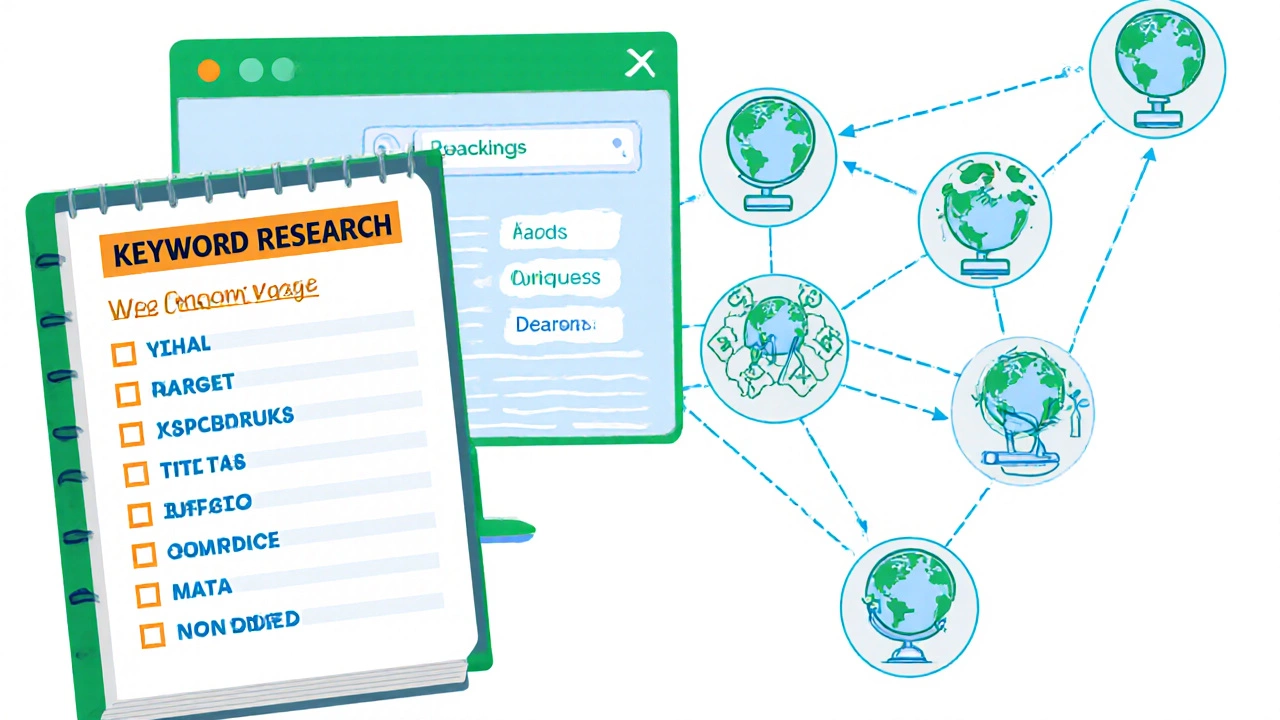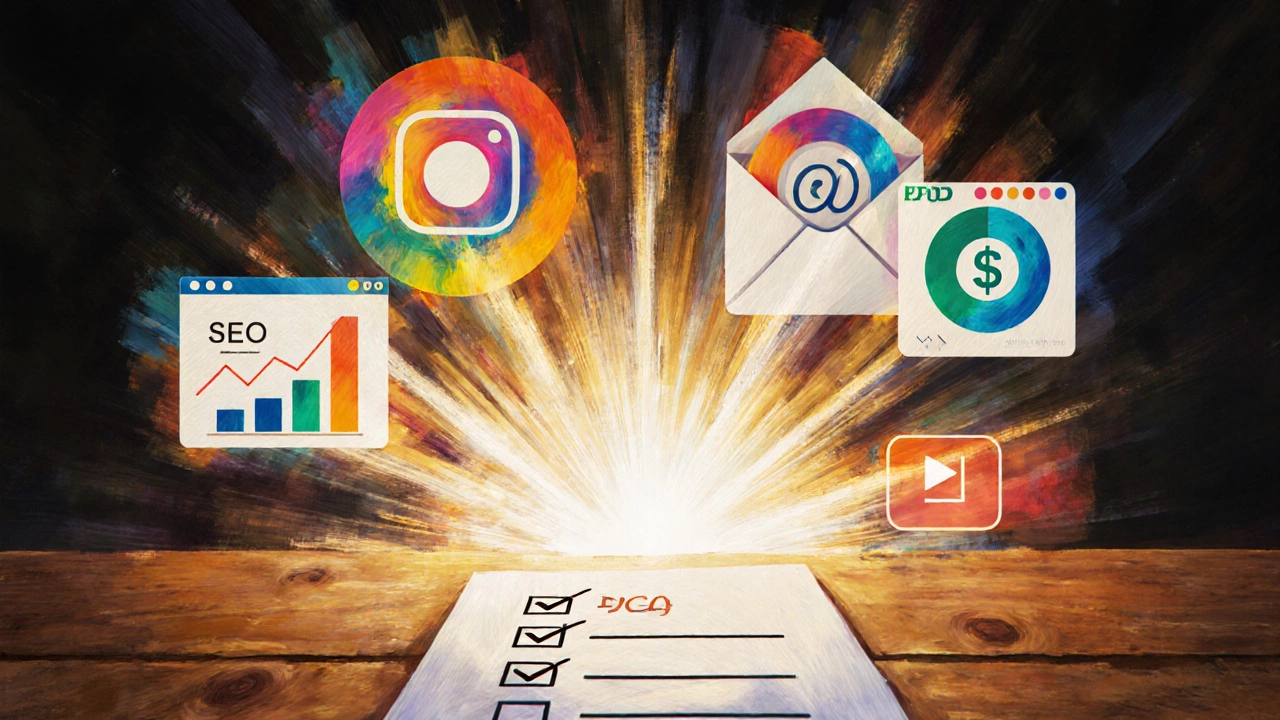
Digital Marketing Channel Calculator
Choose your priorities and let us help you pick the best digital marketing channel for your first campaign.
Rate your priorities
Adjust sliders to weight each factor. Total must equal 100.
Learning Curve
How important is it that this channel is easy to learn?
Initial Cost
How important is it that you can start with minimal or no cost?
Measurable Results
How important is it to see clear, immediate metrics?
Skill Transferability
How important is it that skills learned here apply to other channels?
Your Results
Select your priorities and click "Find My Best Channel" to see your recommendation.
Digital Marketing is a collection of online tactics-search, social, email, video, and more-used to reach and engage audiences on the internet. If you’re just stepping into the field, the biggest question is: which of these tactics gives the fastest win with the smallest learning curve? This guide breaks down the most beginner‑friendly channels, compares their costs and results, and hands you a checklist to launch your first campaign.
What makes a channel beginner‑friendly?
Before we rank the channels, let’s agree on the criteria that matter for newcomers:
- Learning curve - How long does it take to grasp the basics?
- Initial cost - Can you start with a free or low‑budget plan?
- Measurable results - Are there clear metrics to track progress?
- Skill transferability - Do the skills apply to other channels later?
- Community support - Are there tutorials, forums, and case studies to help you troubleshoot?
Keeping these factors in mind, let’s look at each major channel.
1. Search Engine Optimization (SEO) is a process of optimizing website content so it ranks higher in organic search results on engines like Google
SEO feels like a marathon, but the basics are simple: keyword research, on‑page tweaks, and earning backlinks. For beginners, the low cost (you can start with a free WordPress site) and long‑term traffic make it attractive.
Pros: free traffic, evergreen results, transferable skill set.
Cons: takes weeks to months to see rankings, algorithm changes can be confusing.
2. Social Media Marketing (SMM) is a strategy that uses platforms like Facebook, Instagram, LinkedIn, and TikTok to build brand awareness and drive engagement
SMM is the most visual and interactive channel. You can start with a personal profile, create a business page, and run a small ad boost for under $10. The feedback loop is instant-likes, comments, and shares give you real‑time validation.
Pros: quick feedback, low entry cost, massive audiences.
Cons: organic reach can dip without paid support, platform algorithms shift frequently.
3. Email Marketing is a direct messaging method where you send targeted emails to a list of subscribers to nurture leads and drive conversions
Even in 2025, email remains a top‑performing channel for ROI. Tools like MailerLite or ConvertKit offer free tiers up to 1,000 contacts, letting beginners practice list building, copywriting, and automation.
Pros: high ROI (average 4,400% return), full control over audience, easy to measure.
Cons: list acquisition can be slow, spam regulations require careful compliance.

4. Content Marketing is a approach that creates valuable, relevant content-blogs, guides, videos-to attract and retain a clearly defined audience
Think of it as the glue that ties SEO, social, and email together. A well‑crafted blog post can rank on Google, be shared on social, and become an email newsletter centerpiece.
Pros: supports other channels, establishes authority, long‑term traffic.
Cons: time‑intensive, requires consistent publishing schedule.
5. Pay‑Per‑Click Advertising (PPC) is a paid model where advertisers bid for ad placements on search engines or social platforms and pay each time a user clicks
PPC gives immediate traffic, making it ideal for testing offers. Google Ads and Facebook Ads both offer intuitive dashboards and budget caps as low as $5 per day.
Pros: instant results, precise targeting, clear cost control.
Cons: can become expensive without optimization, requires constant monitoring.
6. Affiliate Marketing is a performance‑based model where you promote other companies' products and earn a commission for each sale or lead generated
Affiliate programs (Amazon Associates, ShareASale) let beginners monetize existing content without creating their own products. Success hinges on niche selection and trustworthy reviews.
Pros: low upfront cost, passive income potential, works well with blogs.
Cons: payouts can be small, requires traffic source (often SEO or social).
7. Video Marketing is a strategy that uses video content-YouTube, TikTok, Reels-to educate, entertain, or persuade audiences
Short‑form video has exploded in 2025. Tools like CapCut or InVideo let beginners produce polished clips with no editing background. Video boosts SEO, social reach, and email click‑through rates.
Pros: high engagement, easy to repurpose across platforms, SEO boost.
Cons: equipment and editing skills are a learning curve, algorithm favors consistent posting.

Comparison Table - Which Channel Wins for Beginners?
| Channel | Learning Curve | Initial Cost | Typical ROI (first 6 months) | Best For |
|---|---|---|---|---|
| SEO | Medium | Free‑to‑low (hosting, tools) | 200‑500 % | Long‑term traffic, content creators |
| Social Media | Low | Free‑to‑moderate (ad boost) | 150‑300 % | Visual brands, community builders |
| Low | Free tier up to 1k contacts | 400‑1,200 % | Lead nurturing, e‑commerce | |
| Content Marketing | Medium | Free‑to‑low (host, writing tools) | 250‑600 % | Authority building, SEO support |
| PPC | Low‑Medium | Paid from day 1 (budget $5‑$50/day) | 300‑800 % | Quick testing, product launches |
| Affiliate | Low | Free (join programs) | 100‑300 % | Passive income, niche blogs |
| Video | Medium | Free‑to‑moderate (smartphone, free editors) | 200‑500 % | Engagement‑driven brands, tutorials |
Step‑by‑Step Checklist to Launch Your First Campaign
- Pick a single channel that matches your skill comfort (use the table above).
- Create a simple landing page or profile-keep the design clean and the CTA obvious.
- Define one measurable goal (e.g., 50 sign‑ups, 200 link clicks).
- Gather basic tools:
- SEO: free keyword tool (Ubersuggest), Google Search Console.
- Social: content calendar (Later), basic graphic tool (Canva).
- Email: free MailerLite account.
- PPC: Google Ads demo budget.
- Produce the core asset:
- SEO - a 1,200‑word blog post targeting a long‑tail keyword.
- Social - a carousel or short Reel that solves a quick problem.
- Email - a welcome series of 3 emails with value offers.
- PPC - a single ad copy with a clear headline and single image.
- Launch, then monitor daily:
- SEO - track rankings via Google Search Console.
- Social - watch reach, saves, and comments.
- Email - open and click rates.
- PPC - cost‑per‑click and conversion rate.
- Iterate after 1‑2 weeks based on data (tweak headline, add a call‑to‑action, adjust targeting).
Following this checklist keeps your focus narrow, reduces overwhelm, and gives you data to decide the next channel.
Common Pitfalls and How to Avoid Them
- Spreading too thin. Jumping onto all channels at once dilutes effort. Stick to one, master it, then expand.
- Ignoring analytics. Without tracking, you’ll never know what works. Set up Google Analytics or platform insights from day one.
- Copy‑pasting templates. Personal voice matters. Modify templates to reflect your brand tone.
- Neglecting mobile users. Over 70 % of traffic is mobile; ensure landing pages load fast on phones.
Next Steps - Building a Balanced Digital Marketing Mix
Once you’ve secured a steady flow from your starter channel, add a complementary one. For example, if you began with SEO, layer in email marketing to capture leads from organic traffic. If you started with social, test a small PPC boost to accelerate reach.
Each new channel should feed data back into the others, creating a virtuous cycle of traffic, leads, and sales.
Which digital marketing channel requires the least money to start?
Social media marketing and email marketing can begin with free accounts and minimal spend. Platforms like Instagram or MailerLite let you launch without paying a cent, making them the cheapest entry points.
Can I see results from SEO within a month?
Pure organic rankings usually take 6‑12 weeks for new sites, but you can get early wins by optimizing existing pages, fixing technical errors, and publishing a well‑targeted blog post.
How much should I budget for a beginner’s PPC test?
Start with $5‑$10 per day for 7‑10 days. This gives enough data to evaluate click‑through rates and cost‑per‑acquisition without draining your wallet.
Is email marketing still effective in 2025?
Absolutely. The average ROI remains above 4,000 % according to the 2024 Email Marketing Benchmarks Report, and automation tools have become more beginner‑friendly than ever.
Do I need a website to do affiliate marketing?
A simple blog or even a Medium publication can host affiliate links. The key is to create useful content that convinces readers to click your links.




